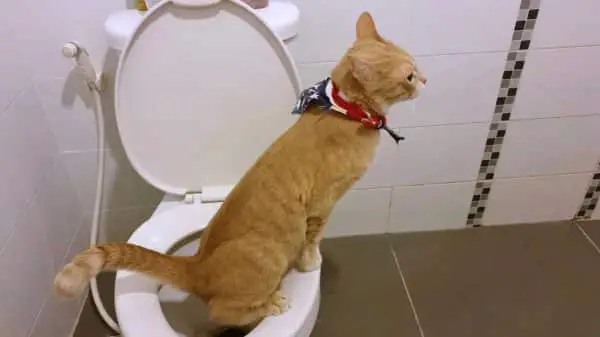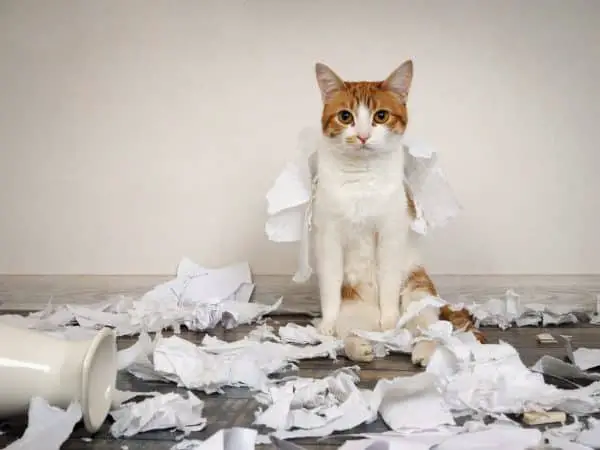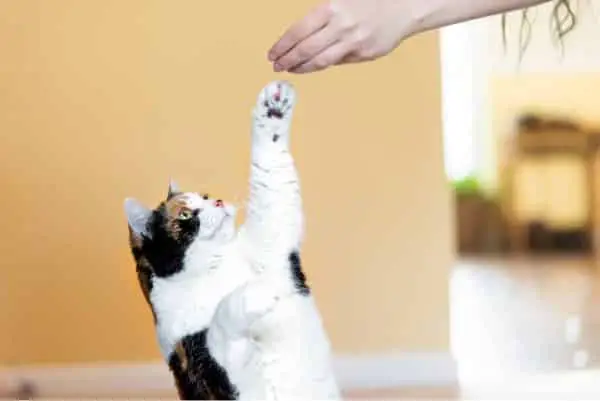Sick of dealing with litter and want to know how to train your cat to use the toilet? Welcome to the club.
Let’s begin with a bit of honesty – toilet training cats can be a little more complicated than simply teaching a cat to use the litter box. You’ll have to be prepared for more setbacks because your cat can’t bury her waste when she uses the toilet and going in the toilet goes against that instinct.
This is especially true if you have a kitten that is younger than six months or a shy and skittish cat. If you have the time and patience, though, your cat could learn how to use the toilet. And that is oh, so worth it – not just for the time and money you’ll save on litter supplies but can you imagine all the hits your toilet going cat video will get on YouTube
Okay, we’re getting ahead of ourselves. Let’s first start with the actual training, shall we? Here’s how it’s done.
How to Train a Cat to Use the Toilet
Yes, it’s a fantasy for many cat owners – a cat who waltzes into the bathroom on her own, perches on the toilet and does her business.
But how hard is it to do
The first thing you need to know is that it really depends on the cat. When I was teaching English in Korea, a friend of mine adopted a stray kitten who was apparently a genius in a fur coat. They set up a litter box for her, which she started using on her own – no training necessary.
But within a few weeks, she abandoned the litter box and started going in the bathroom. There was no training, no transitioning, no encouragement. The smart kitty just observed that all the bigger, hairless cats did their business in the bathroom and simply followed suit.
The thing is – she didn’t do it on the toilet. Korean bathrooms are different from those in the western world and are designed with water drainage for the whole bathroom. The clever cat just chose to do her business right by the drain, which made cleanup super easy for her delighted owners.
If you’ve got a cat who’s a fast study like this one, training her to transition to a toilet isn’t going to be too difficult. It just takes a few simple steps…
Step #1: Choose the kitty bathroom
If you want, you can designate a bathroom for your cat. You might want to do this for a few reasons.
For example, other household members or guests may be grossed out by the idea of using the same toilet as the cat or may put the lid down on the toilet that your cat uses. Which is not great since your cat should always have easy access to the toilet, especially while you’re training him to use the toilet.
Step #2. Get a cat toilet training seat
This is a seat used to cover the toilet seat with a small indent to put litter in. It’s designed to get the cat used to going on the toilet.
A better option is getting a full cat toilet training kit which comes with all the various types of seats you’ll transition through to train your cat to go on the toilet. In my opinion this is hands down the easiest option to quickly guide your cat from the litter box to the toilet.
I had great success with Litter Kwitter. You can find it on Amazon by clicking here.

It comes with the following:
- A white seat, which sits on top of the trays
- Red, amber and green insert trays to transition through the training
- A step-by-step 30-minute training guide that shows you exactly how to use the Litter Kwitter successfully
Here’s how it works.
The Red Stage
The first step is the ‘red stage’ during which you start off by placing the red toilet insert next to the toilet and covering it with kitty liter. Your cat uses it just like a regular litter box at first.

When your cat is used to going in the red insert, move it from the floor to the toilet.

The Amber Stage
The second step is when you simply swap out the red tray for the amber tray, which has a small hole in the center to more closely resemble what a toilet seat feels like.

This is when your cat learns how to steady herself on the toilet and use the little hole in the middle to go in the toilet.
The Green Stage
The third step is to change the amber tray to the green tray, which does not contain any kitty litter, has a bigger hole and looks and feels closest to an actual toilet seat.

By now, your cat is a big girl and able to perch perfectly on the toilet and do her business! This marks the final step to kitty toilet training. Get your treats ready!
Using this program, your cat will be toilet trained in around 8 weeks, ‘though if you’ve got a clever, adjustable kitty, it can be sooner.
If you’d prefer the DIY route, you can also make your own cat toilet seat with an old aluminum roasting pan that you were going to throw away anyway and a little duct tape to secure it. If the pan does not completely cover the toilet bowl, fill the gaps with a little plastic wrap.
If you’re going with the DIY option, make darn sure that the seat is sturdy – there’s no easier way to turn a cat off toilet training than having her fall into the bowl!
Btw, the Litter Kwitter toilet seats are made from the same material that’s used to make a fireman’s hardhat so they’re as durable as they come and purrfectly capable of holding your cat up while she does her business!
If you’re using the Litter Kwitter Toilet Training System, the training ends here. All you have to do is remove the green tray from the toilet seat once your cat has mastered it and voila! you’ve just toilet trained your cat!
If you’re going the DIY route, continue on to the next steps.
Step #3. Place the litter box where you want kitty to go
 Once you’ve chosen the kitty bathroom, put the cat’s litter box in that bathroom, preferably next to the toilet so she can get used to going in that area.
Once you’ve chosen the kitty bathroom, put the cat’s litter box in that bathroom, preferably next to the toilet so she can get used to going in that area.
Every few days, raise the litter box in increments until it is level with the toilet seat. The general rule is to raise it by about three inches a day with stacks of old magazines.
It’s okay to take it more slowly or lower it back down for a day if your cat seems confused. This gradually gets your cat used to going at the toilet bowl level.
She may jump up on the toilet seat to get to her litter box; this is completely acceptable for getting her used to being on the toilet.
Step #4. Replace the litter box with the training seat
Remember that DIY cat toilet training seat you made? Place it on the toilet seat and add flush-able litter. sWheat makes a quality all natural clumping litter. You can find it on Amazon here. Also make sure it’s not going to move around when your cat uses it!
Your cat may have a few accidents at this point. Don’t punish her for it! It just means that she hasn’t learned the purpose of the training seat yet.
Step #5. Start transitioning when your cat is accident-free
Gradually transition through seats that have larger and larger holes in them or use a screwdriver to make a hole in the aluminum roasting pan. Make this hole a little bigger each day, but make sure you don’t do it in a way that’s going to hurt your cat’s feet when she’s on top. Also, gradually decrease the amount of litter you use in the training seat.
After a few weeks, remove the seat. By this point, your cat should be comfortable going directly into the toilet. Be sure to keep an eye on her, though, because she may still have an accident after you’ve removed the seat.
Cats are pretty smart and can be toilet trained if you are very patient and make it a positive experience – i.e. treats!
If they seem to not take to any particular method after a reasonable amount of time, don’t worry about it. They’re not being bad kitties; it’s that their instincts about waste disposal? tend to be rather strong and they might not like any change in their toilet habits. In which case, you might want to start thinking about other litter box alternatives you can try with more success!



